| 28 July |
• yesterday • tomorrow |
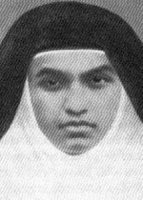
• Alphonsa Muttathupadathu
• Alphonsa of Bharananganam
• Anna Muttathupadathu
• Annakutty
Born in a rural area to Joseph and Mary Muttathupadathu. Baptized on 27 August 1910. Her mother died when Anna was very young, and she was raised by her maternal aunt, and educated by her great-uncle Father Joseph Muttathupadathu. At age 3 she contracted an infected eczema from which she suffered for over a year. Made her first Communion on 27 November 1917. Badly burned on her feet when she accidentally fell into a pit of burning chaff, leaving her permanently partially disabled. Joined the Poor Clare convent at Bharananganam on 2 August 1928, taking the name Alphonsa, and making her vows on 12 August 1936.
She lost her aunt/foster-mother in 1930. Worked as a primary school taught, and the children loved her for her gentleness and cheery way, but health problems often kept her from the classroom. In December 1936 she was miraculously cured from her ailments through the intervention of Saint Therese of Lisieux and Blessed Kuriakose Elias Chavara. However, in June 1939 she was struck by a severe attack of pneumonia, weakening her overall. On 18 October 1940 a thief stumbled into her room in the middle of the night; the shock of the event caused Alphonsa to suffer a loss of memory, and further weakened her. Her condition continued deteriorated for months, and she was given last rites on 29 September 1941; the next day, she regained her memory, though not complete health. She enjoyed some improvement over the next few years, but in July 1945 she developed a stomach problem that eventually led to her death.
She was noted for her suffering, and suffering in silence. Incidents of her intervention began almost immediately upon her death, and often involved the children in the convent school. Hundreds of miraculous cures are claimed for her intervention, many of involving straightening of clubbed-feet, possibly because of her having lived with deformed feet herself; two of these were submitted to the Congregation for the Causes of Saints as proof of her miraculous intervention. The continuing cures are chronicled in the magazine PassionFlower. Thousands converge on the small town of Bharananganam when they celebrate the feast of Saint Alphonsa from 19 to 28 July each year.
19 August 1910 at Kudamalloor, Kerala, India
• 28 July 1946 at Bharananganam, India, of natural causes
• buried in the chapel connected with the cemetery of Saint Mary's church, Bharananganam, India, which has become an important place of pilgrimage
Sunday 12 October 2008 by Pope Benedict XVI
noble ready; battle ready
• against bodily ills
• against illness
• against sickness
• against the death of parents
• sick people
Grains of wheat, when ground in the mill, turn in to flour. With this flour we make the wafer of the holy Eucharist. Grapes, when crushed in the wine press, yield their juice. This juice turns into wine. Similarly, suffering so crushes us that we turn into better human beings. - Saint Alphonsa to novices
She did not want her sufferings to be reduced in the least by human attention and sympathy, nor did she want others of know of her suffering. This is a strange expression of humility, which seeks that others should never think of you. - Cardinal Gracias
https://catholicsaints.info/saint-alphonsa-of-india/
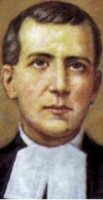
• Manuel Barbal Cosan
• Jakob Hilarius
Raised in a pious and hardworking family near the Pyrenees mountains. Entered the seminary at age 12, but when his hearing began to fail in his teens, he was sent home. Joined the Brothers of the Christian Schools at age 19, entering the noviate on 24 February 1917 at Irun, Spain, taking the name Jaime Hilario. Exceptional teacher and catechist, he believed strongly in the value of universal education, especially for the poor. However, his hearing problems grew worse, and in the early 1930s, he was forced to retire from teaching, and began work in the garden at the LaSalle house at San Jose, Tarragona, Spain.
Imprisoned in July 1936 at Mollerosa, Spain when the Spanish Civil War broke out and religious were swept from the street. Transferred to Tarragona in December, then confined on a prison ship with some other religious. Convicted on 15 January 1937 of being a Christian Brother. Two rounds of volley fire from a firing squad did not kill him, possibly because some of soldiers intentionally shot wide; their commander then murdered Jaime with five shots at close range. First of the 97 LaSalle Brothers killed in Catalunia, Spain during the Spanish Civil War to be recognized as a martyr.
2 January 1898 at Enviny, Lerida, diocese of La Seu d'Urgell, northern Spain as Manuel Barbal Cosan
shot to death on 18 January 1937 at the Mount of Olives cemetery near Tarragona, Spain
21 November 1999 by Pope John Paul II
The day you learn to surrender yourself totally to God, you will discover a new world, just as I am experiencing. You will enjoy a peace and a calm unknown, surpassing even the happiest days of your life. - Saint Jaime Hilario
God be blessed; I'll pray for all of you in heaven. What more could I desire than to die for no other crime but that of being a religious and for having made my contribution to the Christian education of children. Dear father and family, I have been judged and condemned to death. I accept the sentence with joy. No charges have been brought against me. I have been condemned to death only because I am a religious. Do not weep for me, I am not worthy of pity. I shall die for God and for my country. Farewell, I shall be waiting for you in heaven. - Saint Jaime Hilario writing to his family immediately after learning of his death sentence
https://catholicsaints.info/saint-jaime-hilario-barbal/
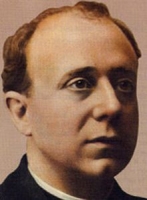
Peter Poveda Castroverde
Raised in a pious family, Pedro felt an early call to the priesthood. He entered the seminary in Jaen, Spain in 1889, then the seminary of Guadix, Grenada, Spain. Ordained on 17 April 1897.
He taught at the seminary, continued his studies, and received his licentiate in theology in Seville, Spain in 1900. He ministered in Guadix to a group of people so poor they lived in caves. He built a school for the children, and provided vocation training to the adults.
Father Pedro was transferred to Madrid, Spain, and was named a canon of the Basilica of Covadonga, Asturius in 1906.
His time in Guadix had impressed Pedro with the need for education for the poor. He prayed on it, and wrote on the need for professional training for teachers. In 1911 he founded the Saint Teresa of Avila Academy, the foundation of the modern Institución Teresiana. He joined the Apostolic Union of Secular Priests in 1912, wrote on the need for more teachers, and opened teacher training centers. He returned to teaching at the seminary at Jaen, served as spiritual director of Los Operarios Catechetical Centre, and taught religion at the Teachers Training School. In 1914 he opened Spain's first university residence for women in Madrid. In 1921 he was transferred to Madrid and was appointed a chaplain of the Royal Palace. In 1922 he was appointed to the Central Board Against Illiteracy, and he continued to work with the Teresian Association; it received papal approval in 1924, and later spread to Chile and Italy.
Martyred in the Spanish Civil War.
3 December 1874 at Linares, Jaen, Spain
shot by firing squad on 28 July 1936 at Madrid, Spain
4 May 2003 by Pope John Paul II
https://catholicsaints.info/saint-pedro-poveda-castroverde/
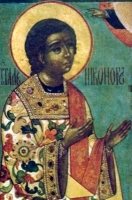
• Nicanor of Cyprus
• Nicanore...
• 10 January (Cypriot Orthodox calendar)
• 4 January (Eastern calendar)
• 6 May (Greek calendar)
Chosen by the Apostles as one of the seven deacons and minister of charities in Jerusalem. Missionary to Cyprus. Martyr.
c.76
At that time, as the number of disciples continued to grow, the Hellenists complained against the Hebrews because their widows were being neglected in the daily distribution. So the Twelve called together the community of the disciples and said, "It is not right for us to neglect the word of God to serve at table. Brothers, select from among you seven reputable men, filled with the Spirit and wisdom, whom we shall appoint to this task, whereas we shall devote ourselves to prayer and to the ministry of the word." The proposal was acceptable to the whole community, so they chose Stephen, a man filled with faith and the holy Spirit, also Philip, Prochorus, Nicanor, Timon, Parmenas, and Nicholas of Antioch, a convert to Judaism. They presented these men to the apostles who prayed and laid hands on them. The word of God continued to spread, and the number of the disciples in Jerusalem increased greatly; even a large group of priests were becoming obedient to the faith. - Acts 6:1-7
https://catholicsaints.info/saint-nicanor-the-deacon/
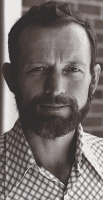
Graduated from Mount Saint Mary's seminary in Maryland. Priest in the archdiocese of Oklahoma City, Oklahoma. A pipe smoker. Missionary to Guatemala in 1968. Murdered for his work and faith.
27 March 1935 in Okarche, Oklahoma
shot at approximately 2am on 28 July 1981 in his rectory in Santiago Atitlán, Sololá, Guatemala
1 December 2016 by Pope Francis (decree of martyrdom)
• 23 September 2017 by Pope Francis
• beatification recognition celebrated at the Cox Convention Center, in Oklahoma City, Oklahoma presided by Cardinal Angelo Amato
A shepherd cannot run away. – Father Stanley
He gave himself fully to his people. He remained with them courageously in a time of darkness. When a wolf threatens a flock, the shepherd remains. He laid down his life for his people long before they came to kill him. – Bishop Anthony Taylor, Diocese of Little Rock, Arkansas
Father Rother laid down his life for Christ and for the people of his parish in Guatemala, whom he dearly loved. – Archbishop Paul Coakley, Archdiocese of Oklahoma City, Oklahoma
https://catholicsaints.info/blessed-stanley-francis-rother/
Parmena
One of the seven deacons appointed by the Apostles to minister to Hellenized Jews of Jerusalem who had converted to Christianity. Their work is described in the Acts of the Apostles. Parmenas preached in Asia Minor. Martyred in the persecutions of Trajan.
98 in Philippi, Macedonia
At that time, as the number of disciples continued to grow, the Hellenists complained against the Hebrews because their widows were being neglected in the daily distribution. So the Twelve called together the community of the disciples and said, "It is not right for us to neglect the word of God to serve at table. Brothers, select from among you seven reputable men, filled with the Spirit and wisdom, whom we shall appoint to this task, whereas we shall devote ourselves to prayer and to the ministry of the word." The proposal was acceptable to the whole community, so they chose Stephen, a man filled with faith and the holy Spirit, also Philip, Prochorus, Nicanor, Timon, Parmenas, and Nicholas of Antioch, a convert to Judaism. They presented these men to the apostles who prayed and laid hands on them. The word of God continued to spread, and the number of the disciples in Jerusalem increased greatly; even a large group of priests were becoming obedient to the faith. - Acts 6:1-7
https://catholicsaints.info/saint-parmenas-the-deacon/

• Botwid of Södermanland
• Botuid, Botuidus, Botvid, Botvido, Botvidus, Botwidus, Botwinus
Raised a pagan in Sweden. He converted to Christianity in England, and then returned home to the region of Södermanland in southeastern Sweden as a missionary. Murdered by an apostate Finnish pagan slave whom Botvid had instructed in the faith. Martyr.
province of Sudermannland, Sweden
• 1120 on the island of Rogö in Lake Mälaren, Sweden
• a healing spring burst from the place of the death
• body remained incorrupt until found by Christians searching for the missing Botvid
• buried at Botkirk, Sudermannland, Sweden
• miracles reported at his grave led to many conversions
• in 1129 a wooden church as built at the burial site
• relics transfered to Botkyrka, Sweden and enshrined in a stone church dedicated to him by archbishop Stephen of Uppsala in 1176
• some relics enshrined in the diocese of Linköping, Sweden
• holding an axe (possibly the weapon used to kill him)
• holding a fish (refers to the legendary story of his death which involved a miracle of a large catch of fish)
https://catholicsaints.info/saint-botwid/
• Prochorus of Nicomedia
• Procoro...
One of the first seven deacons ordained by the Apostles. Bishop of Nicomedia. Miracle worker. Martyr.
1st century Antioch
Prochorus = leader of a chorus
At that time, as the number of disciples continued to grow, the Hellenists complained against the Hebrews because their widows were being neglected in the daily distribution. So the Twelve called together the community of the disciples and said, “It is not right for us to neglect the word of God to serve at table. Brothers, select from among you seven reputable men, filled with the Spirit and wisdom, whom we shall appoint to this task, whereas we shall devote ourselves to prayer and to the ministry of the word.” The proposal was acceptable to the whole community, so they chose Stephen, a man filled with faith and the holy Spirit, also Philip, Prochorus, Nicanor, Timon, Parmenas, and Nicholas of Antioch, a convert to Judaism. They presented these men to the apostles who prayed and laid hands on them. The word of God continued to spread, and the number of the disciples in Jerusalem increased greatly; even a large group of priests were becoming obedient to the faith. – Acts 6:1-7
https://catholicsaints.info/saint-prochorus/

• Samson of Dol
• Sampson of...
Born to the Welsh nobility; brother of Saint Gwenyth of Cornwall and Saint Veep. At age seven, Samson was sent to the abbey of Llanwit Major in South Glamorgan for instruction by the abbot, Saint Illtud. Ordained in 512. Retired to a small monastery on Caldey Island to deepen his prayer life; later chosen its abbot.
Around 516, Samson travelled to Ireland with some Irish monks, hoping to learn from them. However, Samson soon gained a reputation for holiness, and many came to him for prayers on their behalf. Uncomfortable with fame, Samson returned to the anonymity of Cornwall.
Bishop in 520, ordained by Saint Dubricius. Soon after, Samson received a vision from God telling him to evangelize Brittany. He and some monks there established a monastery at Dol that later became the center of a new diocese. Samson spent the rest of his life in Brittany, gaining renown for wisdom, holiness and dedication, and is regarded by many as one of the greatest Welsh saints.
c.490 at south Wales
565 at Dol-de-Bre-ta-paign, Brittany of natural causes
https://catholicsaints.info/saint-samson-of-york/
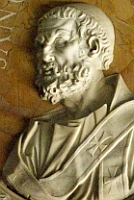
The son of a man named Felix, but little else is known of his early life. 14th pope, reigning during a period of lull in the persecutions of the Church. The first pope from the city of Rome, he began the rise of Latin influence in the Church, the reduction of Greek and Eastern influences.
Decreed that in emergency any kind of water could be used for Baptism. Struggled with bishops of Asia and Africa, insisting that Easter should be celebrated according to the Roman rite, not the Jewish one; at one point he excommunicated all the opposing bishops. Condemned the heresy of Theodotus the Leather-seller who attracted followers in Rome, Italy by preaching that Jesus was a normal man imbued with supernatural powers by Baptism. Saint Jerome refers to Victor as the first Christian author to write about theology in Latin, but only the letters concerning Easter have survived.
in Africa, exact location not recorded
189
martyred 198-199
Calcio, Italy
https://catholicsaints.info/pope-victor-i/
• Davíd of the Blessed Sacrament
• David Carlos
Born to a wealthy family, the son of Domenico Carlos and Gregoria Marañon. Served in the military. He then disappointed his family by following a call to religious life, becoming a Piarist lay brother in Estella, Spain on 4 June 1931, and making his solemn profession on 28 June 1935. Served as gardener and cook for his community. In the persecutions of the Spanish Civil War, priests were automatically murdered, but David was given a chance to live if he would renounce religious life and throw away his habit; he refused. Martyr.
29 December 1907 in Asarta, Navarra, Spain
• shot on 28 July 1936 on the road near Purroy de la Solana, Huesca, Spain
• body burned by his killers
1 October 1995 by Pope Saint John Paul II
https://catholicsaints.info/blessed-david-carlos-maranon/
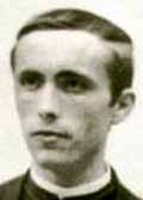
• Manuel of the Virgin of the Pillar
• Emanuele Segura
Worked at the Piarist school in Zaragoza, Spain. Entered the Piarist novitiate at age 18, and was professed in 1901. Ordained in 1907 in the diocese of Barbastro, Spain. Parish priest in the Spanish cities of Barbastro, Tamarite de Litera, Pamplona, Tafalla, Torre de Cascajo and Peralta de la Sal. Had a special ministry to young people who were discerning a call to the priesthood or religious life. Martyred in the Spanish Civil War.
22 January 1881 in Almonacid de la Sierra, Zaragoza, Spain
• shot on 28 July 1936 on the road near Purroy de la Solana, Huesca, Spain
• body burned by his killers
1 October 1995 by Pope Saint John Paul II
https://catholicsaints.info/blessed-manuel-segura-lopez/
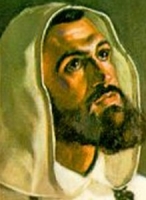
Melchior Garcia Sanpedro
Studied theology at the University of Oviedo. Dominican priest, ordained on 29 May 1847 at the Ocana monastery. Missionary to Vietnam beginning in 1849. Co-adjutor vicar apostolic of Central Tonkin (in modern Vietnam) on 15 April 1853. Imprisoned, tortured and finally executed as one of the Martyrs of Vietnam.
26 April 1821 in in Cortes, Quirós, Asturias, Spain
cut to pieces on 28 July 1858 in Nam Ðinh, Vietnam
19 June 1988 by Pope John Paul II
https://catholicsaints.info/saint-jose-melchor-garcia-sampedro-suarez/
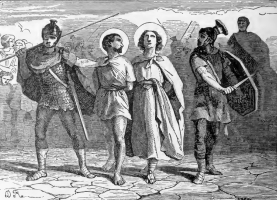
His father was a pagan imperial Roman army officer, his mother Saint Perpetua of Rome. Raised a Christian and taught religion by Saint Peter the Apostle. Friend of and co-worker with Saint Celsus. Evangelized in Milan. Martyred in the first persecution of Nero.
1st century at Rome, Italy
• beheaded c.68 in Milan, Italy
• legend says that when Saint Ambrose of Milan discovered the tomb in 395, Nazarius's blood was still liquid
• relics taken to the basilica of the Apostles in Milan
https://catholicsaints.info/saint-nazarius-of-rome/
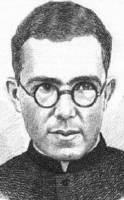
Studied at the Salesian College in Valencia, Spain. Joined the Salesians, making his profession in 1927. Teacher in Sarria, Spain. Ordained in 1936 in the diocese of Valencia. Parish priest in Tibidabo, Spain. At the outbreak of the Spanish Civil War, he set up a shelter for boys to keep them away from the fighting. Imprisoned, tortured and executed in the anti-Christian persecutions of the war. Martyr.
8 August 1907 in Benidoleig, Alicante, Spain
27 July 1936 in Barcelona, Spain
11 March 2001 by Pope John Paul II
https://catholicsaints.info/blessed-jose-caselles-moncho/
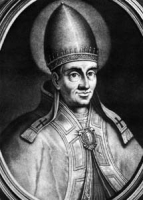
Friend of Saint John Chrysostom. 40th pope. Brought several churches back from the Novatian heresy to orthodoxy. Helped Emperor Honorius oppose the Montanists. Settled the Arian schism at Antioch. Condemned the teachings of Pelagius, and opposed Pelagianism. Opposed Priscillianism. Reigned during the sack of Rome by Alaric the Goth in 410. Maintained the supremacy of the bishop of Rome.
at Albano, Italy
402
12 March 417 at Rome, Italy of natural causes
https://catholicsaints.info/pope-saint-innocent-i/
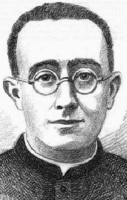
Member of the Salesians, making his profession in 1918. Ordained in 1927. Parish priest in the Spanish cities of Campello, Sarria and Tibidabo. Noted preacher and writer. Imprisoned and executed in the Spanish Civil War. Martyr.
12 October 1902 in Ciudadela, Minorca, Islas Baleares, Spain
during the night of 28 July 1936 in Barcelona, Spain
11 March 2001 by Pope John Paul II
https://catholicsaints.info/blessed-josep-castell-camps/

Friend and co-worker with Saint Nazarius of Rome. Evangelized in Milan. Martyred in the first persecution of Nero.
• beheaded c.68 in Milan, Italy
• relics taken to the basilica of the Apostles in Milan
https://catholicsaints.info/saint-celsus-of-rome/
Layman tailor in Thessaloniki during a period of occupation by Ottoman Turks. Seeing local Christians giving in to pressure and proclaming themselves Muslim, Christodoulus took a cross and went into the streets to encourage Christians, and to offer them the cross to kiss as a sign of their faith. Imprisoned and martyred for this work.
hanged in 1777 in Thessaloniki, Greece
https://catholicsaints.info/blessed-christodoulos/
Camélien
Spiritual student of Saint Loup of Troyes. Bishop of Troyes, France for over 35 years, from 478 until his death. Attended the Council of Orleans in 511 which condemned Arianism in the region.
c.525
https://catholicsaints.info/saint-camelian-of-troyes/
One of seven Christian brothers who were soldiers in the imperial Roman army. Kicked out of the military, exiled and eventually martyred in the persecutions of Maximian.
c.311 at sea near the port of Pityonte (in modern Armenia)
https://catholicsaints.info/saint-longinus-of-satala/
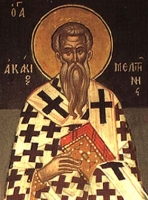
Acacio, Acazio
Bishop who was tortured and martyred in the persecutions of Licinius.
beheaded c.310 at Miletus (in modern Turkey)
https://catholicsaints.info/saint-acacius/
Prayerful, ascetic 9th-century nun at the Chrysobalanton monastery in Bithynia (in modern Turkey). Her reputation for piety and wisdom led to many seeking her out as a spritual director. Lived to an age of 103.
https://catholicsaints.info/saint-irene-of-cappadocia/
Martyrs of Thebes
A large but unspecified number of Christians who were imprisoned, tortured and murdered together in the persecutions of Decius and Valerian.
3rd century Thebes, Egypt
https://catholicsaints.info/martyrs-of-thebaid/
Lenican, Lucan, Luicano
Monk. Founded and served as first abbot of the monastery of Killucan (Killuquin; Cill Liúcainne) in the barony of Farbill, Westmeath, Ireland.
6th-century Ireland
https://catholicsaints.info/saint-liuican/
Lyutis
Monk at Monte Cassino Abbey. In later life he retired from the community to live as a prayerful hermit near the abbey of La Cava.
c.1038 at La Cava, Italy
https://catholicsaints.info/saint-lyutius/
Eustasius, Eustacius
Tortured and drowned in a river in Galatia, date unknown. Martyr.
https://catholicsaints.info/saint-eustathius-of-galatia/
Second century priest near Lyons, France during the persecutions of Severus. Late in life he lived as a hermit on an island in the River Saône.
https://catholicsaints.info/saint-peregrinus/
Fourteen Claretian clerics who were martyred together in the Spanish Civil War. -
• Abelardo García Palacios
• Angel López Martínez
• Angel Pérez Murillo
• Antonio Lasa Vidauretta
• Antonio Orrego Fuentes
• Cándido Catalán Lasala
• Claudio López Martínez
• Gabriel Barriopedro Tejedor
• Jesús Aníbal Gómez y Gómez
• Melecio Pardo Llorente
• Otilio Del Amo Palomino
• Primitivo Berrocoso Maillo
• Tomás Cordero y Cordero
• Vicente Robles Gómez
28 July 1936 in Fernán Caballero, Ciudad Real, Spain
13 October 2013 by Pope Francis
https://catholicsaints.info/martyrs-of-fernan-caballero/
Thousands of people were murdered in the anti-Catholic persecutions of the Spanish Civil War from 1934 to 1939. I have pages on each of them, but in most cases I have only found very minimal information. They are available on the CatholicSaints.Info site through these links:
• Blessed Antolín Astorga Díez
• Blessed Enrique Serra Chorro
• Blessed Gregorio Charlez Ribera
• Blessed Joan Ayats Plantalech
• Blessed Joan Bover Teixidor
• Blessed Joan Costa Canal
• Blessed José Aurelio Calleja de Hierro
• Blessed José Gutiérrez Arranz
• Blessed Josep Camí y Camí
• Blessed Josep Martí Coll
• Blessed Lluis Casanovas Vila
• Blessed Lorenzo Arribas Palacio
• Blessed Manuel Collellmir Sentíes
• Blessed Miguel Léibar Garay
• Blessed Pedro Alonso Fernández
• Blessed Pelagi Ayats Vergés
• Blessed Pere Vilar Espona
• Blessed Primitivo Sandín Miñambres
• Blessed Ramon Gros Ballbé
• Blessed Vicente Toledano Valenciano
• Anthony della Chiesa
• Astolfo Lobo
• Comgall of Galloon
• Leubace of Sennevières
• Modeste of Chartres
• Paul of Xiropotamou
• Pitirim of Tambov
• Ramón Emiliano Hortelano Gómez
• Sabino Hernández Laso
• Sancha of Majorca
CatholicSaints.Info Portable Edition